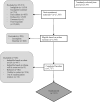Exploring Gender Differences in Veterans in a Secondary Analysis of a Randomized Controlled Trial of Mindfulness for Chronic Pain
- PMID: 38404673
- PMCID: PMC10890953
- DOI: 10.1089/whr.2023.0086
Exploring Gender Differences in Veterans in a Secondary Analysis of a Randomized Controlled Trial of Mindfulness for Chronic Pain
Abstract
Background: Although studies have documented higher rates of chronic pain among women Veterans compared to men Veterans, there remains a lack of comprehensive information about potential contributors to these disparities.
Materials and methods: This study examined gender differences in chronic pain and its contributors among 419 men and 392 women Veterans, enrolled in a mindfulness trial for chronic pain. We conducted descriptive analyses summarizing distributions of baseline measures, obtained by survey and through the electronic health record. Comparisons between genders were conducted using chi-square tests for categorical variables and t-tests for continuous measures.
Results: Compared to men, women Veterans were more likely to have chronic overlapping pain conditions and had higher levels of pain interference and intensity. Women had higher prevalence of psychiatric and sleep disorder diagnoses, greater levels of depression, anxiety, post-traumatic stress disorder, fatigue, sleep disturbance, stress and pain catastrophizing, and lower levels of pain self-efficacy and participation in social roles and activities. However, women were less likely to smoke or have a substance abuse disorder and used more nonpharmacological pain treatment modalities.
Conclusion: Among Veterans seeking treatment for chronic pain, women differed from men in their type of pain, had greater pain intensity and interference, and had greater prevalence and higher levels of many known biopsychosocial contributors to pain. Results point to the need for pain treatment that addresses the comprehensive needs of women Veterans.
Clinical Trial Registration Number: NCT04526158. Patient enrollment began on December 4, 2020.
Keywords: chronic pain; mindfulness; veterans; women.
© Diana J. Burgess et al., 2024; Published by Mary Ann Liebert, Inc.
Conflict of interest statement
No competing financial interests exist.
Similar articles
-
Pre-deployment programmes for building resilience in military and frontline emergency service personnel.Cochrane Database Syst Rev. 2021 Dec 6;12(12):CD013242. doi: 10.1002/14651858.CD013242.pub2. Cochrane Database Syst Rev. 2021. PMID: 34870330 Free PMC article.
-
Psychological therapies for women who experience intimate partner violence.Cochrane Database Syst Rev. 2020 Jul 1;7(7):CD013017. doi: 10.1002/14651858.CD013017.pub2. Cochrane Database Syst Rev. 2020. PMID: 32608505 Free PMC article.
-
Exercise interventions and patient beliefs for people with hip, knee or hip and knee osteoarthritis: a mixed methods review.Cochrane Database Syst Rev. 2018 Apr 17;4(4):CD010842. doi: 10.1002/14651858.CD010842.pub2. Cochrane Database Syst Rev. 2018. PMID: 29664187 Free PMC article.
-
Cannabis use, risk of cannabis use disorder, and anxiety and depression among bisexual patients: A comparative study of sex and sexual identity differences in a large health system.Drug Alcohol Depend. 2025 Sep 1;274:112762. doi: 10.1016/j.drugalcdep.2025.112762. Epub 2025 Jun 20. Drug Alcohol Depend. 2025. PMID: 40561790
-
Epidural versus non-epidural or no analgesia for pain management in labour.Cochrane Database Syst Rev. 2018 May 21;5(5):CD000331. doi: 10.1002/14651858.CD000331.pub4. Cochrane Database Syst Rev. 2018. PMID: 29781504 Free PMC article.
Cited by
-
Complementary and Integrative Health Therapies and Pain: Delivery Through Veterans Affairs and Community Care.Glob Adv Integr Med Health. 2025 Jul 8;14:27536130251358757. doi: 10.1177/27536130251358757. eCollection 2025 Jan-Dec. Glob Adv Integr Med Health. 2025. PMID: 40657238 Free PMC article.
-
The efficacy of neurostimulation techniques for the management of chronic pain associated with bone disorders: A systematic review and meta-analysis.Surg Neurol Int. 2025 Apr 18;16:137. doi: 10.25259/SNI_521_2024. eCollection 2025. Surg Neurol Int. 2025. PMID: 40353170 Free PMC article. Review.
-
The Use of Complementary Health Approaches Among U.S. Veterans from 2002 to 2022: a Prevalence and Sex-Stratified Analysis.J Gen Intern Med. 2025 May 20. doi: 10.1007/s11606-025-09620-5. Online ahead of print. J Gen Intern Med. 2025. PMID: 40394441 No abstract available.
References
-
- Relieving Pain in America: A Blueprint for Transforming Prevention, Care, Education, and Research Institute of Medicine (US) Committee on Advancing Pain Research, Care, and Education. National Academy of Sciences: Washington, DC; 2011. - PubMed
-
- Fillingim RB. Sex, Gender, and Pain. Principles of Gender-Specific Medicine. Elsevier; 2017; pp. 481–496; doi: 10.1016/B978-0-12-803506-1.00038-3 - DOI
-
- Hoffmann DE, Fillingim RB, Veasley C. The woman who cried pain: Do sex-based disparities still exist in the experience and treatment of pain? J Law Med Ethics 2022;50(3):519–541. - PubMed

